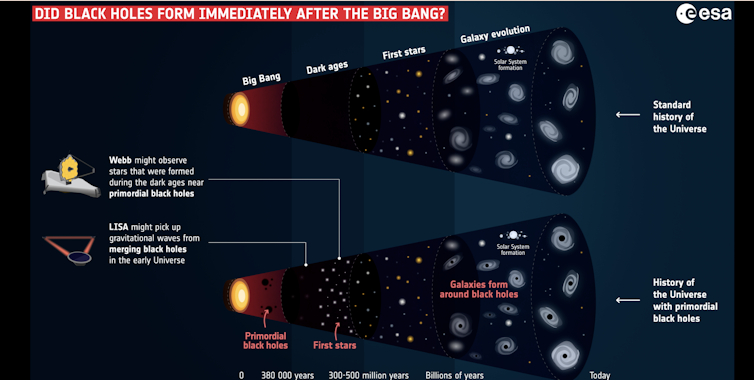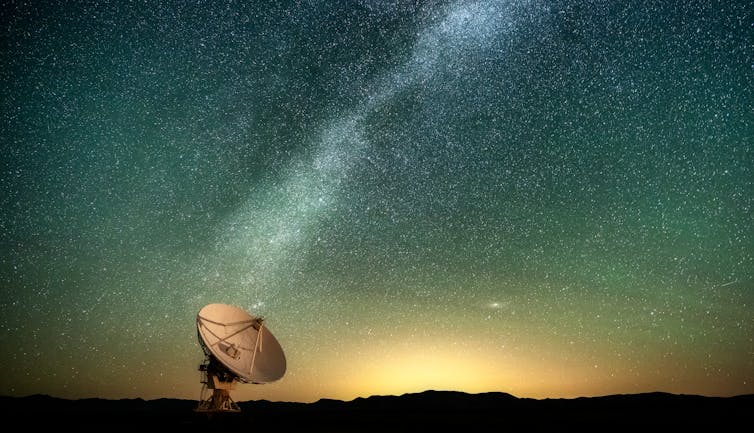The Higgs particle could have ended the universe by now – here’s why we’re still here
Although our universe may seem stable, having existed for a whopping 13.7 billion years, several experiments suggest that it is at risk – walking on the edge of a very dangerous cliff

Estimated reading time: 11 minutes
And it’s all down to the instability of a single fundamental particle: the Higgs boson.
In new research by me and my colleagues, just accepted for publication in Physical Letters B, we show that some models of the early universe, those which involve objects called light primordial black holes, are unlikely to be right because they would have triggered the Higgs boson to end the cosmos by now.
The Higgs boson is responsible for the mass and interactions of all the particles we know of. That’s because particle masses are a consequence of elementary particles interacting with a field, dubbed the Higgs field. Because the Higgs boson exists, we know that the field exists.
You can think of this field as a perfectly still water bath that we soak in. It has identical properties across the entire universe. This means we observe the same masses and interactions throughout the cosmos. This uniformity has allowed us to observe and describe the same physics over several millennia (astronomers typically look backwards in time).
But the Higgs field isn’t likely to be in the lowest possible energy state it could be in. That means it could theoretically change its state, dropping to a lower energy state in a certain location. If that happened, however, it would alter the laws of physics dramatically.
Such a change would represent what physicists call a phase transition. This is what happens when water turns into vapour, forming bubbles in the process. A phase transition in the Higgs field would similarly create low-energy bubbles of space with completely different physics in them.
In such a bubble, the mass of electrons would suddenly change, and so would its interactions with other particles. Protons and neutrons – which make up the atomic nucleus and are made of quarks – would suddenly dislocate. Essentially, anybody experiencing such a change would likely no longer be able to report it.
Constant risk
Recent measurements of particle masses from the Large Hadron Collider (LHC) at Cern suggest that such an event might be possible. But don’t panic; this may only occur in a few thousand billion billion years after we retire. For this reason, in the corridors of particle physics departments, it is usually said that the universe is not unstable but rather “meta-stable”, because the world’s end will not happen anytime soon.
To form a bubble, the Higgs field needs a good reason. Due to quantum mechanics, the theory which governs the microcosmos of atoms and particles, the energy of the Higgs is always fluctuating. And it is statistically possible (although unlikely, which is why it takes so much time) that the Higgs forms a bubble from time to time.
However, the story is different in the presence of external energy sources like strong gravitational fields or hot plasma (a form of matter made up of charged particles): the field can borrow this energy to form bubbles more easily.
Therefore, although there is no reason to expect that the Higgs field forms numerous bubbles today, a big question in the context of cosmology is whether the extreme environments shortly after the Big Bang could have triggered such bubbling.
However, when the universe was very hot, although energy was available to help form Higgs bubbles, thermal effects also stabilised the Higgs by modifying its quantum properties. Therefore, this heat could not trigger the end of the universe, which is probably why we are still here.
Primordial black holes
In our new research, we showed there is one source of heat, however, that would constantly cause such bubbling (without the stabilising thermal effects seen in the early days after the Big Bang). That’s primordial black holes, a type of black hole which emerged in the early universe from the collapse of overly dense regions of spacetime. Unlike normal black holes, which form when stars collapse, primordial ones could be tiny – as light as a gram.

The existence of such light black holes is a prediction of many theoretical models that describe the evolution of the cosmos shortly after the Big Bang. This includes some models of inflation, suggesting the universe blew up hugely in size after the Big Bang.
However, proving this existence comes with a big caveat: Stephen Hawking demonstrated in the 1970s that, because of quantum mechanics, black holes evaporate slowly by emitting radiation through their event horizon (a point at which not even light can escape).
Hawking showed that black holes behave like heat sources in the universe, with a temperature inversely proportional to their mass. This means that light black holes are much hotter and evaporate more quickly than massive ones. In particular, if primordial black holes lighter than a few thousands billion grams formed in the early universe (10 billion times smaller than the Moon’s mass), as many models suggest, they would have evaporated by now.
In the presence of the Higgs field, such objects would behave like impurities in a fizzy drink – helping the liquid form gas bubbles by contributing to its energy via the effect of gravity (due to the mass of the black hole) and the ambient temperature (due to its Hawking radiation).
When primordial black holes evaporate, they heat the universe locally. They would evolve in the middle of hot spots that could be much hotter than the surrounding universe, but still colder than their typical Hawking temperature. What we showed, using a combination of analytical calculations and numerical simulations, is that, because of the existence of these hot spots, they would constantly cause the Higgs field to bubble.
But we are still here. This means that such objects are highly unlikely to ever have existed. In fact, we should rule out all of the cosmological scenarios predicting their existence.
That’s of course unless we discover some evidence of their past existence in ancient radiation or gravitational waves. If we do, that may be even more exciting. That would indicate that there’s something we don’t know about the Higgs; something that protects it from bubbling in the presence of evaporating primordial black holes. This may, in fact, be brand new particles or forces.
Either way, it is clear that we still have a lot to discover about the universe on the smallest and biggest scales.![]()
Lucien Heurtier, Postdoctoral Research Associate, King's College London
This article is republished from The Conversation under a Creative Commons license. Read the original article.
What's Your Reaction?























